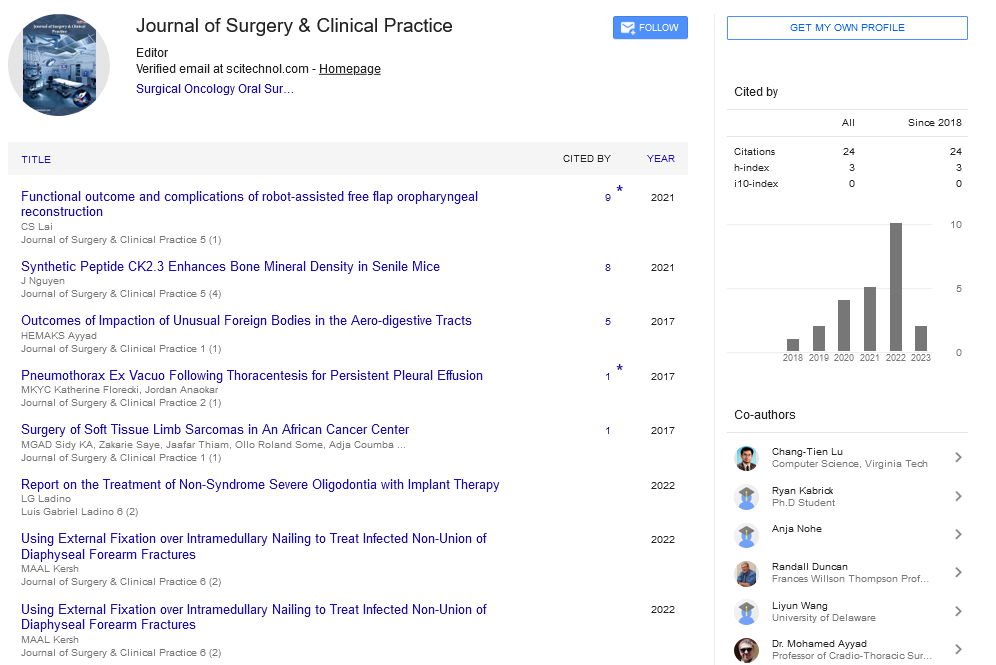The effect of flaxseed powder & oil on reduction of hyperglycemia and associated parameters in streptozotocin-induced diabetic rats
Suha Hashim Abduljawad
Taibah University, Saudi Arabia
: J Surg Clin Pract
Abstract
Introduction: The global prevalence of obesity has reached an alarming rate. In addition to obesity and chronic diseases, high prevalence of micronutrient deficiencies especially iron deficiency anemia (ADA) was observed in many countries.. Among the different potential causes of iron deficiency, the sequestration of iron through an inflammatory mediated was identified as the most probable cause of iron deficiency in obesity. Adipose tissue is recognized as an endocrine organ that contribute to the inflammatory process by secreting proinflammatory cytokines, and The role of hepcidin in the regulation of iron metabolism has been emphasized in recent years. Hepcidin represents the main regulator of intestinal iron absorption and macrophage iron release and, thus, ultimately of the iron available for erythropoiesis.
Objectives: To examine the relationship between fat distribution (WC, total body fat %, and trunk fat %), iron status biomarkers and hepcidin in obese Qatari adults
Methods: Diabetes mellitus was induced in Sprague- Dawley rats using a single injection of multiple low-dose streptozotocin (20, 40 and 60 mg/kg/day, i.p). The rats were divided into six groups consisting of 5 rats in each group. CD, diabetes control; CFP, normal rats feed on diet contain 10% flaxseed powder; CFO, normal rats feed on diet contains 4% flaxseed oil; DFP, diabetic rats feed on diet contain 10% flaxseed powder; DFO, diabetic rats fed on a diet containing 4% flaxseed oil. The measurable parameters were; body weight gain (BWG), food intake (FI), feed efficiency ratio (FER), Total glutathione (GSH), Superoxide dismutase (SOD), Catalase (CAT), blood glucose, total cholesterol (TC), Triglycerides (TG) and high-density lipoprotein cholesterol (HDL-C).
Results: There was a significant decrease in BWG (P<0.05) in DFP and DFO groups when compared with C groups. The highest significant increase (p< 0.01) of GSH levels and SOD and CAT activity were seen in group CFP when compared to CD group. Supplementation with flaxseed powder in the diet was more effective than flaxseed oil in the reduction of blood glucose level of diabetic rats. DFP group showed the lowest significant (P<0.05) decreasing in TC, TG and LDL-C, and the highest significant (P<0.05) increasing in HDL-C as compared to diabetic CD group. Conclusion: Diabetic rats in a group which were treated with 10% flaxseed powder were able to partly recover from STZ -induced diabetes within eight weeks when compared to DC group.
Biography
Suha Hashim Abduljawad has completed her PhD at the age of 32 years from king Saud University and Postdoctoral Studies from food and nutrition collage, King Saud University, Saudi Arabia. She has published more than 15 papers in reputed journals and has been serving as an editorial board member of repute.
E-mail: suha_hashem@yahoo.com
 Spanish
Spanish  Chinese
Chinese  Russian
Russian  German
German  French
French  Japanese
Japanese  Portuguese
Portuguese  Hindi
Hindi 
